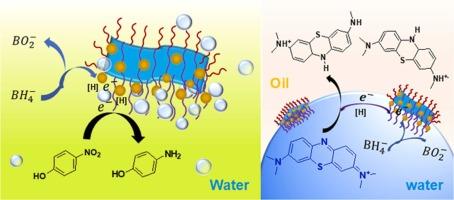Effect of composition of Janus nanosheets on their emulsion stabilization and catalytic reduction properties
IF 5.4
2区 化学
Q2 CHEMISTRY, PHYSICAL
Colloids and Surfaces A: Physicochemical and Engineering Aspects
Pub Date : 2025-09-30
DOI:10.1016/j.colsurfa.2025.138511
引用次数: 0
Abstract
Janus nanosheets with asymmetrical structure and composition exhibit superior performance in emulsion stabilization and interfacial catalysis compared to homogeneous nanoparticles. In this paper, Janus silica nanosheets containing a phenyl group (JSNP) and Janus silica nanosheets containing an octyl group with hydrophobic functionality (JSNO) were prepared, respectively. Janus catalysts loaded with Ag nanoparticles were prepared using the impregnation reduction method for the catalytic reduction of 4-nitrophenol (4-NP) and methylene blue (MB). The effects of the composition and surface properties of Janus nanosheets on their emulsion stability and catalytic reduction performance for 4-NP were systematically analyzed. The results showed that the hydrophilic/hydrophobic ratio of the nanosheets and the type of hydrophobic functional groups play a key role in the emulsification of the Janus nanosheets and the catalytic efficiency of 4-NP. Among them, the hydrophilic/hydrophobic ratio (1:1) JSNP-Ag showed stronger emulsion stability and 4-NP catalytic performance. Based on the asymmetric structure of JSNP and good dispersion of Ag nanoparticles, the JSNP-Ag catalysts exhibited broad-spectrum catalytic reduction performance in oil-water inhomogeneous phase systems for methylene blue solutions with concentrations ranging from 16.7 to 167 mg/L. In addition, cycling experiments showed that JSNP-Ag exhibited good stability against 4-NP over 5 cycles and methylene blue over 8 cycles. The fundamental insights into the structure-performance relationship of Janus-type catalysts in this work are instructive for developing efficient and sustainable catalytic systems.

Janus纳米片的组成对其乳液稳定性和催化还原性能的影响
具有不对称结构和组成的Janus纳米片在乳液稳定和界面催化方面表现出优于均相纳米片的性能。本文分别制备了含有苯基的Janus二氧化硅纳米片(JSNP)和含有疏水性辛基的Janus二氧化硅纳米片(JSNO)。采用浸渍还原法制备了载银纳米颗粒的Janus催化剂,用于催化还原4-硝基苯酚(4-NP)和亚甲基蓝(MB)。系统分析了Janus纳米片的组成和表面性质对其乳液稳定性和催化还原性能的影响。结果表明,纳米片的亲疏水比和疏水官能团类型对Janus纳米片的乳化效果和4-NP的催化效率起关键作用。其中,亲疏水比为1:1的JSNP-Ag具有较强的乳液稳定性和4-NP催化性能。基于JSNP的不对称结构和Ag纳米粒子良好的分散性,JSNP-Ag催化剂在浓度为16.7 ~ 167 mg/L的亚甲基蓝溶液中,在油水非均相体系中表现出广谱的催化还原性能。循环实验表明,JSNP-Ag对4-NP和亚甲基蓝的稳定性分别达到5个循环和8个循环。本研究对janus型催化剂的结构-性能关系的基本认识对开发高效和可持续的催化体系具有指导意义。
本文章由计算机程序翻译,如有差异,请以英文原文为准。
求助全文
约1分钟内获得全文
求助全文
来源期刊
CiteScore
8.70
自引率
9.60%
发文量
2421
审稿时长
56 days
期刊介绍:
Colloids and Surfaces A: Physicochemical and Engineering Aspects is an international journal devoted to the science underlying applications of colloids and interfacial phenomena.
The journal aims at publishing high quality research papers featuring new materials or new insights into the role of colloid and interface science in (for example) food, energy, minerals processing, pharmaceuticals or the environment.

 求助内容:
求助内容: 应助结果提醒方式:
应助结果提醒方式:


